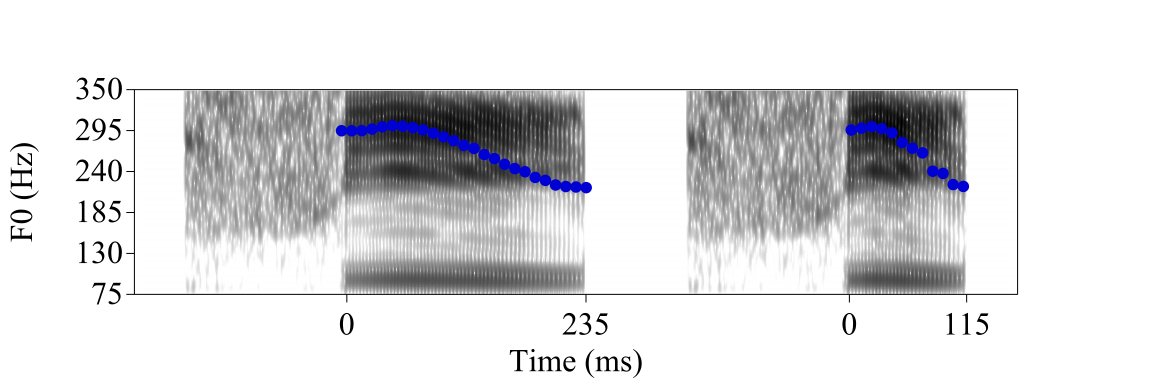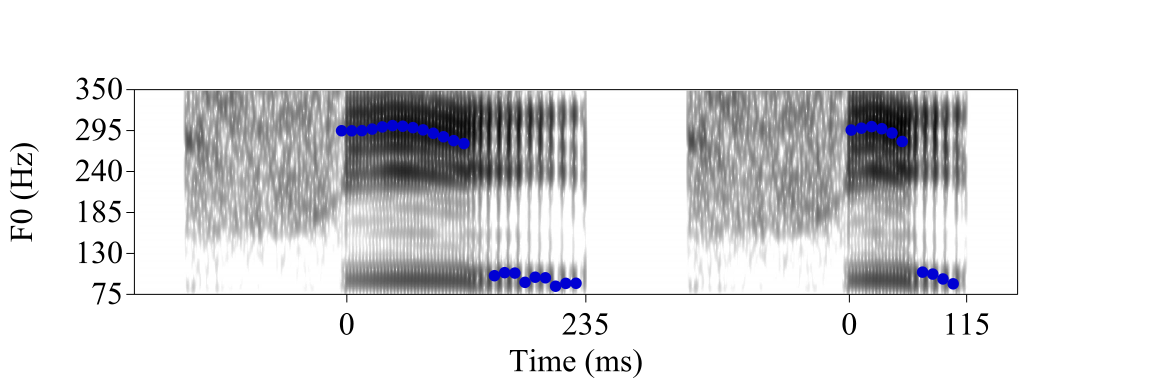Research interests
Cue weighting in the perception of multi-dimensional contrasts
Contrasts in tone and phonation are frequently multi-dimensional. My research focuses on the independent effect of each acoustic cue in phonetically multi-dimensional contrasts. My study on the effect of glottalization position and duration on the perception of glottalized phonations in Zapotec systematically manipulated the position of glottalization and duration in vowels. The results reveal that the position of glottalization is a more reliable cue than duration in phonation identification in Sierra Norte Zapotec. Rearticulated vowels favor stimuli with modal voicing before and after glottalization, regardless of the relative length of the modal voicing. Checked vowel percept requires glottalization to be at the end of vowel with no following modal portion in the vowel. Listeners are also sensitive to the relative proportion of glottalization in the vowel and the degree of glottalization. Larger proportion of glottalization elicits more rearticulated phonation percept. A stronger magnitude of glottalization in the middle of vowel strengthens the perception of rearticulated phonation; a stronger magnitude of glottalization elicits higher percentage of checked phonation responses. This study for the first time systematically tested the effect of glottalization position in glottalized phonation perception. This work is presented at Sound System of Latin America (SSLA) 4 and at Study of the Indigenous Languages of the Americas (SSILA) 2025 and 2026. The manuscript for this study is available here.
Fieldwork on San Francisco Yateé Zapotec
San Francisco Yateé Zapotec is spoken in the town of San Francisco Yateé, Sierra Norte, Oaxaca, Mexico. I started the documentation work on Yateé Zapotec in the spring of 2020 in collaboration with two native speakers of Yateé Zapotec, Briseida Mendez and Adrián Fernández. Our goal is to produce a linguistic description of the language from all aspects and to create teaching materials for the language.
Yateé Zapotec has three phonation types: modal, checked, and rearticulated phonations. Checked phonation has late-phased glottalization relative to vowels; rearticulated phonation has mid-phased glottalization relative to vowels. The language also has three tones: high, low, falling, and rising. The three phonations and the four tones are fully crossed with each other. We have collected audio and electroglottography data of the minimal/near minimal pairs of all the phonation and tone combinations. Our results are presented at ICPhS 2023. The proceedings are available here.
Besides the phonetics of phonation and tone in Yateé Zapotec, we are also interested in the morphological role of phonation and tone in the language. We found that phonation can be the only difference between imperative clauses and past tense clauses for certain verbs. Our findings is presented at SSILA 2024 Annual Meeting. The abstract for the presentation is available here. The slides are available here.
We are committed to build open-accessed data base for the language. We are in construction of a Living Dictionary of the language. Each entry in the dictionary is annotated with Yateé Zapotec alphabet, IPA transcription, and Spanish and English glosses, accompanied by audio recordings from the community members.
Acoustics of falsetto voice and breathy voice
While breathy voice and creaky voice has been relatively well-studied, the acoustics of falsetto calls for more investigations. Breathy voice is characterized by having a high amplitude in the fundamental frequency, but low energy in the high frequencies (Hillenbrand & Houde, 1996). Houde. Falsetto voice, while perceptually distinct from creaky voice with its characteristically high pitch and “thin” voice quality, has been described as being acoustically very similar to breathy voice. It has a strong fundamental frequency energy, but fewer and weaker high-frequency harmonics (Colton, 1972, 1973; Neiman, 1997). Collaborating with Professor Patricia Keating, we annotated the phonation of the vowels in a corpus with people narrating the Little Red Riding Hood story with breathy and falsetto voices. Some of our findings are contrary to the literature: while falsetto voice indeed has fewer harmonics than breathy voice, their high-frequency energy is actually stronger than modal and breathy voices.
Acoustics of creaky voice
“Creaky voice” refers to a number of different kinds of voice production with similar percepts. Collaborating with Professors Patricia Keating, Marc Garellek, and Jody Kreiman, we study the acoustic properties of different kinds of creaky voice. There are three key properties of creaky voice: low F0, irregular F0, and constricted glottis. Prototypical creaky voice has all three properties. We find that none of the three properties are necessary to create a creaky percept. Low F0 and irregular F0 alone are sufficient to create a creaky percept. The combination of low F0 and irregular F0; and of low F0 and constricted F0 are also sufficient to create a creaky percept.
Our finds were presented as a poster at the 184th meeting of Acoustic Society of America in Chicago.
Checked syllables, vowels, and tones
Checked syllables usually have the characteristics of being short, having glottalization at the end of the syllable, and being associated with specific tones. Such syllables are usually found in Chinese languages and Otomanguean languages. Xiapu Min, the language I do fieldwork on, has such syllables (i.e. Checked tone 5 /θiʔ5/湿 “wet”). However, there has not been consensus on what the acoustic and articulatory features of checked syllables are cross-linguistically. My dissertation topic is “Phonetics of checked syllables and vowels”, aiming to investigate how checked syllables and vowels are produced and what acoustic features are important for listeners to identify a checked syllable.
Phonetics of checked tones in citation and sandhi forms in Xiapu Min
We measure the F0, H1-H2, HNR, duration, and voice quality of the two checked tones, high-falling-checked Tone 5 and low-falling-checked Tone 2 in Xiapu Min. We compared the phonetic properties of checked tones with their unchecked tone minimal pairs. We found that in citation forms, checked tones are shorter than unchecked ones. Their F0 is different from unchecked tones in the F0 space. Checked tones are realized with glottalized quality in the end, whereas unchecked tones have a modal quality.
In sandhi forms, checked tones are neurtralized with unchecked tones in F0 and voice quality. However, checked tones remain to be shorter than unchecked tones after sandhi.
The manuscript of this study has been submitted to Languages special issue and currently under review. manuscript
- A minimal pair of the seven lexical tones in Xiapu Min
| Segment | Word | Gloss |
|---|---|---|
| /θi44/ | 诗 | poem |
| /θi42/ | 死 | die |
| /θi35/ | 四 | four |
| /θi23/ | 是 | to be |
| /θi11/ | 时 | time |
| /θiʔ5/ | 湿 | wet |
| /θiʔ2/ | 实 | concrete |
Perception of checked tones in citation forms in Xiapu Min
The production results show that checked tones in Xiapu Min are characterized by short duration, vowel-final glottalization, and distinct F0. We ask whether listeners make use all three features when identifying a checked tone, and whether they rely on one feature more than the others.
We manipulated those three variables and invited Xiapu Min listeners to participate in a forced-choice identification task. The results show that short duration is the most important cue, followed by creaky voice quality. F0 appears to be least important among the three cues.
The results have been presented as a poster at 181st Annual Meeting of Acoustic Society of America. poster
- Spectrogram of sample manipuated stimuli (Top-left: F0 of T5, Long,
Modal; Top-right: F0 of T5, Short, Modal; Bottom-left: F0 of T5, Long,
Creaky; Bottom-right: F0 of T5, Short, Creaky)


Voice quality
I am interested in the production of voice quality in general. I have studied the effect of F0, utterance position, and sentence type on the production of creak in Mandarin utterances. The manuscript has been published at the San Diego Linguistic Papers (SDLP) Issue 8. escholarship link
Language acquisition
I study how the phonological system of people’s native language influences their acquisition of non-native languages. My Master’s thesis from CU Boulder discusses how Mandarin speakers discriminate English vowels, and whether their discrimination accuracies can be predicted by the way they assimilate English vowels into Mandarin categories. The revised manuscript has been published at the the San Diego Linguistic Papers (SDLP) Issue 9. escholarship link